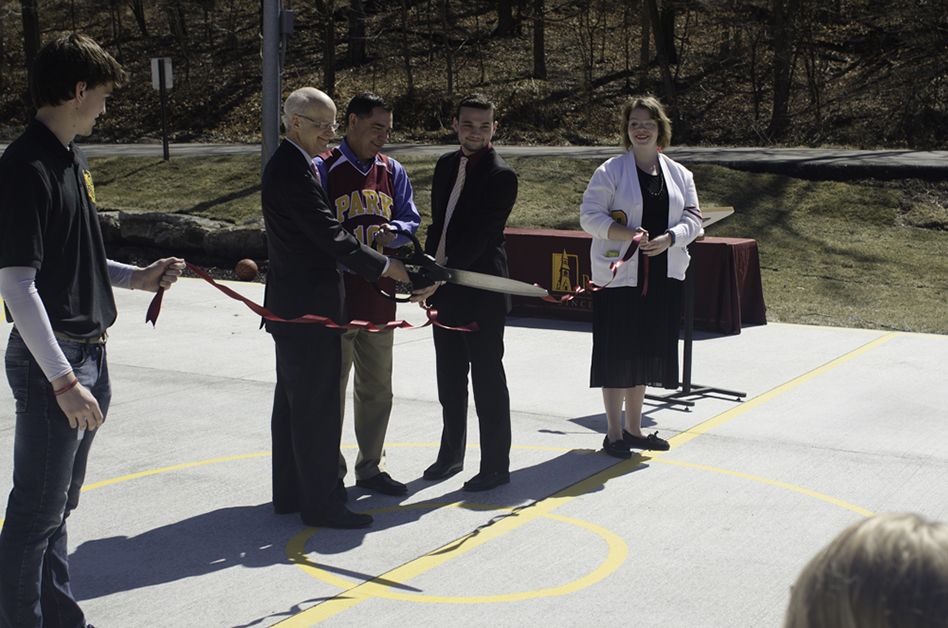 Royce Skocny’s inspiration helped spur along the construction of a new on-campus outdoor basketball facility at Park University, named after the school’s most famous mule.
Royce Skocny’s inspiration helped spur along the construction of a new on-campus outdoor basketball facility at Park University, named after the school’s most famous mule.
On Friday, March 20, officials held a ribbon-cutting ceremony to officially open Old Kate Court — the idea of a 2014 graduate, U.S. Navy Veteran and current employee. There were $25,000 in student funds and a $44,000 gift from the Sunderland Foundation involved in the new, state-of-the-art facility.
Skocny came up with the idea after observing an area pickup game before finding a harsh reality on Park’s campus.
“I looked around and found a cracked and overgrown outdoor basketball court on campus, and apparently, I started griping about it quite a bit,” he said in an interview with Park Magazine.
While serving as a workstudy student in the Office of Military and Veteran Student Services, a fellow student suggested Skocny stop complaining and take action. He went on to serve a term with the Park Student Government Association and used that post to begin exploring the idea of building a new intramural court.
A student poll favored the idea, and the PSGA voted to use reserve funds for the project.
“Royce’s vision, initiative and enthusiasm captured everyone’s attention,” Park associate dean of students Jayme Uden told Park Magazine. “I was happy to help him connect with various university groups to identify additional funding opportunities.”
Uden worked with Skocny to coordinate with other Park student organizations, including the Residence Hall Council, which agreed to combine resources with the PSGA for a total of $25,000.
On behalf of students, Park’s Office of External Relations & Marketing Communications approached the Sunderland Foundation to partner with the student groups to provide the additional funds needed to begin construction, which began last fall after receiving a $44,000 grant from the Foundation.
“Once word got out that students were willing to commit their own reserved funds to make this happen, other Park groups stepped in to help us keep the ball rolling,” Skocny said.
In addition to the 50-by-80-foot concrete slab for the court, the project includes a 2-foot retaining wall with limestone boulders sourced from the Parkville campus to direct water flow away from the court while providing a natural source for seating. The new court was completed with a 10-foot fence and a timed lighting system.
Designed larger than a standard basketball court, the space offers students access not only to a new court where they can also play the popular half-court soccer, but also a new multipurpose outdoor space for activities and events.
“We had the funds to install a basic court, but it was the grant from the Sunderland Foundation that enabled us to create something better than we imagined,” said Jeremy Barnes, PSGA president and junior chemistry major.
After considering various Pirate-themed names, Park students unanimously voted to name the facility after a campus legend.
Old Kate was a beloved mule that hauled water to the Parkville campus for more than a decade before her death in 1900 — the same year that Park’s new waterworks began pumping water to campus buildings. Her independence and resourcefulness endeared her to students.
The faithful mule knew the daily route and walked it herself, and when finished, Old Kate headed for the barn where she waited patiently to be unharnessed.
Mournful students buried Old Kate near what is now the concession stand for Julian Field. Many Park alumni still pay respects where her stone is located adjacent to the seating area. In 1932, the wheels from her cart were fashioned into chandeliers that still hang in Park’s McCoy Meetin’ House.
Overall, the project encompassed many of the traditions from Park, especially the nod to the past while trying to build a better future.
“It not only looks awesome, but it represents the power of positive collaboration at Park,” said Skocny, who is now employed full-time at Park as an admissions representative.

